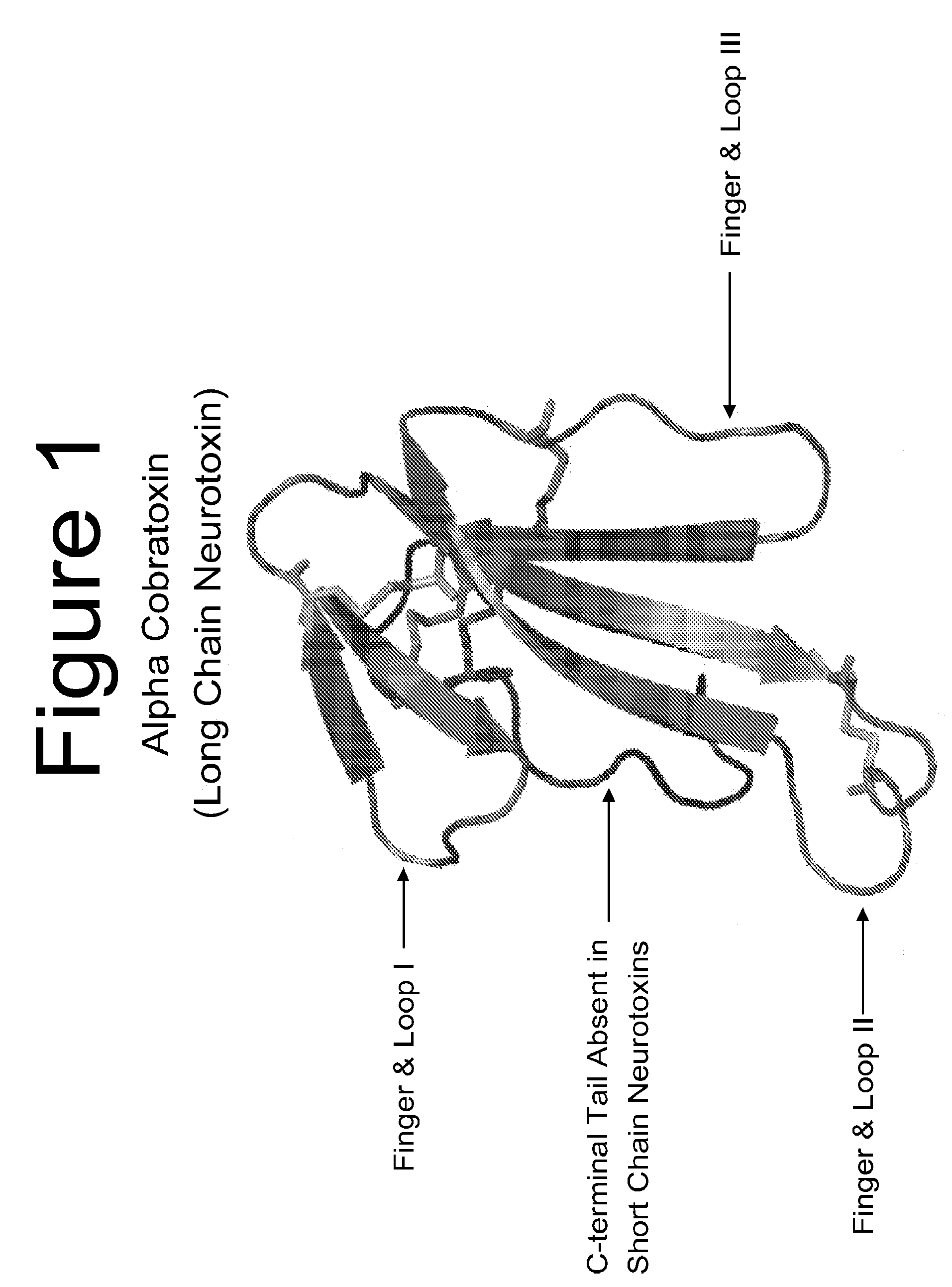Postsynaptically Targeted Chemodenervation Agents and Their Methods of Use
a chemodenervation agent and postsynaptic technology, applied in the field of neuromuscular disorders, can solve the problems of inability to gauge the effective dosage in real time, postsynaptic chemodenervation produces long-lasting but temporary paralysis, etc., to reduce the toxicity of the subject composition, prolong the paralysis, and reduce the effect of toxicity
- Summary
- Abstract
- Description
- Claims
- Application Information
AI Technical Summary
Benefits of technology
Problems solved by technology
Method used
Image
Examples
example 1
Molecular cloning of cDNAs encoding α-neurotoxins from Snake Venom Glands
[0134]The following experimental procedure exemplifies the molecular cloning of the long chain alpha neurotoxin-coding cDNA pool using the Asian Cobra Naja kaouthia as the biological source. One skilled in the art understands that this procedure with the universal neurotoxin primer sequences provided can be used for cloning analogous sequences from any species of the Elapidae and Hydrofilidae taxons.
[0135]The venom glands of a single N. kaouthia specimen were surgically removed from the skull immediately after decapitation of the animal. The extracted glands were quickly dissected with a razor blade on a Petri dish placed on ice. The dissected gland tissue was transferred into a 2 ml Eppendorf tubes containing lysis buffer (10 ul buffer per 1 mg tissue). The lysis of the gland tissue was completed by vortexing the lysis suspension on a Thermomixer (Eppendorf AG, Hamburg Germany) at maximum speed at 4° C. for 30...
example 2
Culturing Cells of Fetal Human Skeletal Muscle Cells Expressing Human Muscular nAChR (α1,β1,γ,δ)
[0138]Any technique known in the art for culturing mammalian cells can be employed to culture human fetal HSkMC (pre-screened HSkMC, Cell Applications Inc., San Diego, Cat#5150-05f).
[0139]The preferred technique for growing HSkMC cells employs “Skeletal Muscle Cell Growth Medium” (Cell Applications Inc., San Diego, Cat# 151-500) in an atmosphere of 90% air and 5% CO2 at 37° C. following the cell supplier's recommendation.
[0140]Small volumes are grown in 35 mm dishes using an innoculum of 3×105 cells in 1.5 ml of medium. After three days the medium is changed, and optimal AChR yield is obtained on day six or seven.
[0141]For large volumes, plastic roller bottles (Falcon Labware, Becton-Dickinson, Inc., Oxnard, Calif. U.S.A.) are used. In the case of 850 cm2 bottles, 3×107 cells are inoculated in 150 ml of medium; whereas, for 1750 cm2 bottles, 6×107 cells are inoculated in 300 ml of medium....
example 3
Selective Reduction and Alkylation of the 5TH Disulfide Bond in Long Chain α-Cobratoxin 1 from N. KAOUTHIA
[0142]For selective reduction of the 5th dilsulfide bond in loop II 1.2 mM of the toxin is incubated with 2.5 mM dithiothreitol in 0.2 M Tris buffer, pH 8.5, 1 mg / ml EDTA for 90 min at 4° C. Thereafter, 2,2′-dithiopyridine dissolved in methanol is added to a final concentration of 15 mM and incubated for 1 h at room temperature. The alkylated Cobratoxin-dithiopyridine obtained is purified by gel filtration (Bio-Gel P-2) and HPLC chromatography (Vydac C8). One skilled in the art understands that this procedure can be applied for selective reduction of any long chain α-neurotoxin that shares the common three finger fold with α-bungarotoxin and α-cobratoxin. The exemplified toxins were only chosen based on their commercial availability in purified form.
PUM
| Property | Measurement | Unit |
|---|---|---|
| Frequency | aaaaa | aaaaa |
| Molar volume | aaaaa | aaaaa |
| Composition | aaaaa | aaaaa |
Abstract
Description
Claims
Application Information
 Login to View More
Login to View More - R&D
- Intellectual Property
- Life Sciences
- Materials
- Tech Scout
- Unparalleled Data Quality
- Higher Quality Content
- 60% Fewer Hallucinations
Browse by: Latest US Patents, China's latest patents, Technical Efficacy Thesaurus, Application Domain, Technology Topic, Popular Technical Reports.
© 2025 PatSnap. All rights reserved.Legal|Privacy policy|Modern Slavery Act Transparency Statement|Sitemap|About US| Contact US: help@patsnap.com

